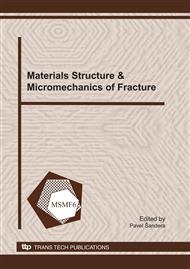p.227
p.231
p.235
p.239
p.243
p.247
p.251
p.255
p.259
Influence of Case Hardening on Fatigue Resistance of Models of Hollow Shafts with Production Surface Defects
Abstract:
This work analyses an influence of case hardening on fatigue resistance of models of hollow shafts which have a variable diameter ranging from 40 mm to 67 mm, wall thickness of 7 mm and production surface defects on an inner surface layer of the hollow shafts. Case hardened (on both sides) and non case hardened shafts were tested. Both types of shafts were made out of 16MnCrS5 (DIN) steel by cold reduction rolling and were subjected to a flat bending. Tests indicated that the fatigue resistance of the case hardened shafts was significantly higher. The main reason for the lower resistance of the non case hardened shafts was initiation of magistral cracks from the defects on inner surfaces. In case of the case hardened shafts the magistral cracks initiated from the notch on outer surfaces where macroscopic stress was maximal. Different mechanisms of the cracking are discussed from the point of view of compressive residual stresses in the case hardened layer.
Info:
Periodical:
Pages:
243-246
Citation:
Online since:
January 2011
Authors:
Keywords:
Price:
Сopyright:
© 2011 Trans Tech Publications Ltd. All Rights Reserved
Share:
Citation:


